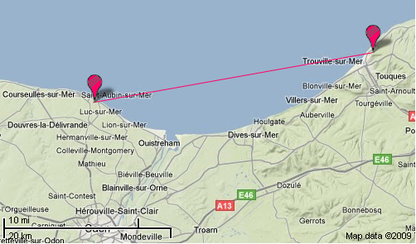Five months have elapsed since that first week-end when my encounter with Android was a severe case of culture shock. With significant daily experience of the device, I can now form a more mature judgement of its capabilities and its potential – of course from my own highly subjective point of view.
I still hate having to use Google Calendar and Google Contacts for synchronization. I hope that SyncML synchronization will appear in the future, make Android a better desktop citizen and provide more choice of end points. Meanwhile I use Google. With that out of the way, let’s move on to my impressions of Android itself.
I am grateful for features such as a decent web browser on a mobile device, for a working albeit half baked packaging and distribution system, and for Google Maps which I consider both a superlative application in its own right and the current killer albeit proprietary infrastructure for location enabled applications. But the rigidly simple interface that forces behaviours upon its user feels like a straitjacket : the overbearing feeling when using Android is that its designers have decided that simplicity is to be preserved at all costs regardless of what the user prefers.
Why can’t I select a smaller font for my list items ? Would a parameter somewhere in a customization menu add too much complication ? Why won’t you show me the raw configuration data ? Is it absolutely necessary to arbitrarily limit the number of virtual desktops to three ? From the point of a user who is just getting acquainted with such a powerful platform, those are puzzling questions.
I still don’t like the Android ‘s logic, and moreover I still don’t quite understand it. Of course I manage to use that system, but after five month of daily use it still does not feel natural. Maybe it is just a skin-deep issue or maybe I am just not the target audience – but some features are definitely backwards – package management for example. For starters, the “My Downloads” list is not ordered alphabetically nor in any apparently meaningful order. Then for each upgradeable package, one must first browse to the package, then manually trigger the upgrade package, then acknowledge system privileges the upgraded package and finally clear the download notification and the update notification. Is this a joke ? This almost matches the tediousness of upgrading Windows software – an impressive feat considering that the foundations of Android package management seem serious enough. Where is my APT ?
Like any new user on a prosperous enough system, I am lost in choices – but that is an embarrassment of riches. Nevertheless, I wonder why basics such as a task manager are not installed by default. In classic Unix spirit, even the most basic system utilities are independent applications. But what is bearable and even satisfying on a system with a decent shell and package management with dependencies becomes torture when installing a package is so clumsy and upgrading it so tedious.
Tediousness in package management in particular and user interaction in general makes taming the beast an experience in frustration. When installing a bunch of competing applications and testing them takes time and effort. Experimenting is not the pleasure it normally is on a Linux system. The lack of decent text entry compounds the feeling. Clumsy text selection makes cut and paste a significant effort – something Palm did make quick, easy and painless more than ten years ago. Not implementing pointer-driven selection – what were the developers thinking ?
PIM integration has not progressed much. For a given contact, there is no way to look at a communications log that spans mail, SMS and telephony: each of them is its own separate universe. There is no way to have a list of meetings with a given contact or at given location.
But there basic functionality has been omitted too. For example when adding a phone number to an existing contact, search is disabled – you have to scroll all the way to the contact. There is no way to search the SMS archive and SMS to multiple recipients is an exercise left to applications.
Palm OS may have been unstable, incapable of contemporary operating system features, offering only basic functionality and generally way past its shelf date. But in the mind of users, it remains the benchmark against which all PIM systems are judged. And to this day I still don’t see anything beating Palm OS on its home turf of PIM core features and basic usability.
Palm OS was a poster child for responsiveness, but on the Android everything takes time – even after I have identified and killed the various errant applications that make it even slower. Actually, the system is very fast and capable of feats such as full-motion video that were far beyond the reach of the Palm OS. But the interaction is spoilt by gratuitous use of animations for everything. Animations are useful for graphically hinting the novice user about what is going on – but then hey are only a drag. But please let me disable animations as I do on every desktop I use !
The choice of a virtual keyboard is my own mistake and I am now aware that I need a physical keyboard. After five months, I can now use the virtual keyboard with enough speed and precision for comfortable entry of a couple of sentences. But beyond that it is tiring and feels too clumsy for any meaningful work. This is a major problem for me – text entry is my daily bread and butter. I long for the Treo‘s keyboard or even the one on the Nokia E71 – they offered a great compromise of typing speed and compacity. And no multitouch on the soft keyboard means no keyboard shortcuts which renders many console applications unusable – sorry Emacs users.
The applications offering is still young and I cannot blame it for needing time to expand and mature. I also still need to familiarize myself with Android culture an develop the right habits to find my way instinctively and be more productive. After five months, we are getting there – one handed navigation has been done right. But I still believe that a large part of the user interface conventions used on the Android does not match the expectations for general computing.
It seems like everything has been meticulously designed to bury under a thick layer of Dalvik and Google plaster anything that could remind anyone of Unix. It is very frustrating to know that there is a Linux kernel under all that, and yet to suffer wading knee-deep in the marshes of toyland. The more I use Android an study it, the more I feel that Linux is a mere hardware abstraction layer and the POSIX world a distant memory. This is not the droid I’m looking for.


